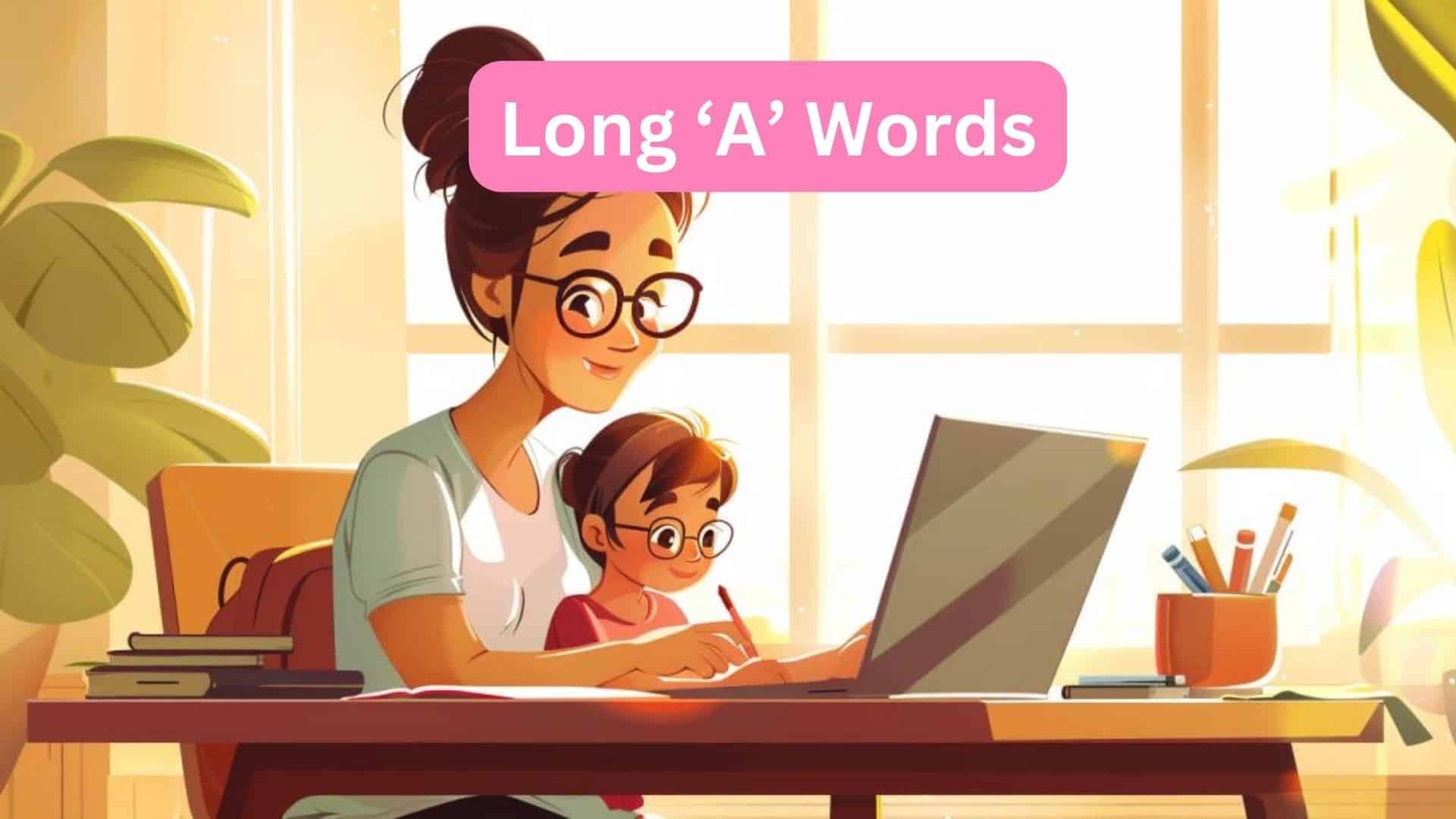Activities for Teaching Long ‘A’ Words to Elementary Students
Teaching long ‘A’ words to young learners can be challenging.
You may struggle to keep students engaged and motivated as they learn these new patterns.
But what if there were fun, hands-on activities that could make teaching long ‘A’ words a breeze?
Get ready to transform your lessons with exciting games and exercises that will have your students mastering long ‘A’ words in no time! I
This blog post will explore creative ways to teach long ‘A’ words, making learning enjoyable for you and your students.
Basic Understanding of Long ‘A’ Sounds

Long ‘A’ sounds are essential for students to master as they develop their reading and writing skills.
Unlike short ‘A’ sounds, which are found in words like “cat” or “hat,” long ‘A’ sounds are pronounced like the name of the letter A itself.
Characteristics of Long ‘A’ Sounds
A long ‘A’ sound is a vowel sound pronounced like the letter ‘A,’ such as in the word “ape.”
Some other examples of words with long ‘A’ sounds include “cake,” “make,” “late,” “plane,” and “crane.”
By familiarising themselves with these examples, students can better identify the long ‘A’ sound in various words.
Common Spellings of Long ‘A’ Sounds
One of the most common spelling patterns for the long ‘A’ sound is the A-e pattern, where an ‘e’ at the end of the word makes the preceding ‘a’ say its name, like in “cake” and “make.”
Another typical pattern is ‘ai,’ which represents the long ‘A’ sound in words such as “rain,” “train,” and “pain.” The ‘ay’ pattern is often used at the end of words, like in “play,” “stay,” and “day.”
As students advance, they may encounter less common patterns, such as ‘a’ with a silent ‘e’ at the end of vowel teams like ‘ea’ (in “break”) and ‘ei’ (in “vein”).
It’s important to provide immediate practice opportunities.
This can include simple matching or fill-in-the-blank exercises, such as worksheets where students match words to pictures or use words in context to complete sentences.
By understanding the characteristics and common spelling patterns of long ‘A’ sounds, students can more easily decode unfamiliar words and improve their reading comprehension.
Encourage students to listen to these sounds during daily reading or read-aloud sessions to reinforce their learning.
Activities for Reinforcing Long ‘A’ Words
| Learning Style | Activities |
|---|---|
| Visual | Charts, diagrams, and infographics Videos, animations, and slideshows Mind maps and graphic organizers Posters, pictures, and illustrations Color coding and visual highlighting |
| Auditory | Lectures and discussions Audio recordings and podcasts Oral presentations and debates Storytelling and read-aloud Jigsaw activities and group discussions |
| Kinesthetic | Hands-on experiments and simulations Role-playing and drama activities Manipulatives and interactive models Field trips and real-world applications Movement-based activities (e.g., gestures, dance) |
1. Visual and Interactive Activities
Visual aids and interactive activities are crucial in helping students understand and retain the spelling and pronunciation of long ‘A’ words.
By engaging with the material hands-on, students can better internalize the concepts being taught.
Matching Games
- Purpose: Matching games aid in visual recognition and recall, helping students associate the written form of a word with its corresponding image or meaning.
- Setup: To create matching games, use online tools or physical cards. Prepare pairs of cards, one featuring a long ‘A’ word and the other displaying a related image.
- Examples: Create pairs such as ‘cake’ with a picture of a cake or ‘train’ with an image of a train. Students then match the word cards to their corresponding images.
Sorting Tasks
- Purpose: Sorting activities help students differentiate between the various spelling patterns of the long ‘A’ sound, reinforcing their understanding of when to use each pattern.
- Setup: Set up sorting activities using digital platforms or physical materials. Label bins or sections with the different long ‘A’ spelling patterns (‘ai,’ ‘ay,’ ‘a_e,’ etc.).
- Examples: Provide students with word cards featuring examples like ‘rain,’ ‘stake,’ and ‘play.’ Have them sort the words into the appropriate categories based on their spelling patterns.
2. Writing and Spelling Exercises Overview
Writing and speaking exercises are essential for reinforcing phonics skills, as they help improve spelling accuracy and pronunciation.
Students can better retain the information by actively engaging with the words through writing and speaking.
Fill-in-the-Blank Worksheets
- Purpose: Fill-in-the-blank worksheets enhance a student’s ability to recognize and use long ‘A’ words correctly within the context of a sentence.
- Creation: When creating these worksheets, select words that showcase different long ‘A’ spelling patterns and create context-rich sentences with blanks where the long ‘A’ words should be placed.
- Examples: Provide sample sentences like “I need to _____ my shoes before I go out,” where students would fill in ‘lace,’ or “The _____ is my favorite animal,” where students would write ‘ape.’
Spell and Speak Activities
- Purpose: Spell and speaking activities help build confidence in verbal skills and spelling, allowing students to practice using long ‘A’ words in a communicative setting.
- Setup: Organize classroom activities where students spell and pronounce long ‘A’ words in various interactive formats.
- Examples: Conduct spelling bees focused on long ‘A’ words or have students engage in peer quizzes where they ask each other to spell and use long ‘A’ words in sentences.
3. Integration with Technology
Incorporating technology into learning activities can provide students with engaging and interactive ways to reinforce their understanding of long ‘A’ words.
Digital Tools and Resources
- Purpose: Digital tools offer a variety of interactive games and activities tailored to learning vowel sounds, making the learning process more engaging and enjoyable for students.
- Suggestions: Recommend educational apps and websites that focus on teaching and reinforcing long vowel sounds, such as ABC Mouse, Starfall, or PBS Kids.
- Examples: Use apps that allow custom word lists and games like word searches or digital crosswords featuring long ‘A’ words. These tools can provide additional practice opportunities and cater to various learning styles.
By incorporating a mix of visual, interactive, writing, and technology-based activities, teachers can create a well-rounded approach to reinforcing long ‘A’ words in their classrooms, helping students master these essential phonics skills.
Advanced Practice Techniques
- They must move beyond these foundational skills and apply their knowledge in varied contexts.
- By engaging in advanced practice techniques, students can solidify their understanding of long ‘A’ words, making their learning more enduring and effective.
1. Application in Context
- Learning long ‘A’ words in context, helps students grasp the ‘how’ and the ‘why’ of using these words.
By encountering long ‘A’ words in meaningful sentences and scenarios, students can better understand their usage and develop a more comprehensive understanding of the language.
- Engage students in sentence construction exercises where they use long ‘A’ words in their sentences.
This activity enhances creativity and comprehension, as students must consider the meaning and context of the words they use. For example, provide students with a list of long ‘A’ words and have them create original sentences incorporating those words.
- Integrate long ‘A’ words into everyday classroom communication and tasks to make the learning process continuous and integrated. Use long ‘A’ words when giving instructions, feedback, or praise, and encourage students to do the same.
This real-life application reinforces the importance and relevance of the words they are learning.
2. Game-Based Learning
Educational Gaming Benefits
Game-based learning offers numerous cognitive and motivational benefits. Educational games can enhance memory retention, increase engagement, and create positive associations with learning.
By incorporating games into long ‘A’ word practice, students are more likely to stay motivated and actively participate in learning.
Bingo Games Set up
Bingo games tailored to long ‘A’ words. Create bingo cards featuring a mix of long ‘A’ words and their corresponding images.
Call out the words or show the images, and have students mark off the matching squares on their cards. This game encourages both listening and visual recognition skills.
Consider using less common long ‘A’ words or varying the spelling patterns to keep the game challenging.
Word Hunts Organize
‘Word Hunts’ is where students search for hidden long ‘A’ words, either physically around the classroom or in a printed word search.
Provide a list of words for students to find, and set a time limit to add an element of challenge.
Variations can include team competitions or progressively more difficult word lists. Word Hunts promote active engagement and reinforce spelling patterns.
Continuous Engagement and Assessment
Use these advanced practice activities not only for learning but also for continuous assessment.
Observe students during games and activities to gauge their understanding and pronunciation skills.
This informal assessment approach allows teachers to identify areas where students may need additional support or challenge.
Encouragement for Diverse Application
Encourage educators to adapt these activities to suit their classroom dynamics and student needs.
By tailoring the activities and promoting adaptability and creativity in teaching methods, teachers can create a more engaging and effective learning environment for their students.
By incorporating advanced practice techniques such as contextual learning, game-based activities, and continuous assessment, educators can help students deepen their understanding and application of long ‘A’ words, ultimately leading to more successful and enduring learning outcomes.
Conclusion
Teaching long ‘A’ words is an essential building block for developing strong literacy skills in elementary students.
Educators can help students master this crucial vowel sound by using a variety of engaging activities, from interactive games to real-world applications.
Providing ample practice opportunities, continuously monitoring progress, and offering targeted feedback will reinforce learning and boost confidence.
As students gain proficiency with long ‘A’ words, they’ll be better equipped to tackle more advanced reading and writing challenges.
However, learning doesn’t stop in the classroom—parents can support skill development at home through simple, everyday activities.
Teachers and families can set students up for long-term success by working together.
Ready to get started? Choose an activity from this post and watch your students’ understanding of long ‘A’ words soar!
Frequently Asked Questions
What are Some Common Spelling Patterns for Long ‘A’ Words?
Common spelling patterns for long ‘A’ words include ‘a_e’ (as in “cake”), ‘ai’ (as in “rain”), ‘ay’ (as in “play”), and ‘ea’ (as in “break”).
How Can I Make Learning Long ‘A’ Words Engaging for My Students?
Incorporate fun activities like word sorts, matching games, and interactive online exercises to keep students engaged. You can also use real-world examples.
What Should I do if a Student struggles with Long ‘A’ Words?
Use multisensory techniques, such as having students trace the words while saying the sounds aloud. Regularly assess their progress and offer targeted feedback to help them improve.
How can Parents Support Their Child’s Learning of Long ‘A’ Words at Home?
They read books with long ‘A’ words, play word games, and encourage their child to write stories or messages using these words. They can also create a dedicated learning space and praise their child’s efforts to boost confidence.
How Does Teaching Long ‘A’ Words Fit into the Overall Literacy Curriculum?
Teaching long ‘A’ words is a crucial component of phonics instruction. It helps students develop foundational reading and writing skills, decode unfamiliar words more easily, and improve their fluency and comprehension.









pin-up casino giris: pin up azerbaycan – pin up casino